Political perspectives vary too much to be contained in a bipartisan system
3 min read
Ikon Images/Getty Images
By TESS OSMER
Contributing Writer
While growing up, we were always told that at dinner parties and social events, there are three topics one should never mention: politics, religion and money. These days, however, it has become popular to crusade for our opinions in regards to all three.
Mostly this phenomenon came to me as reflective of the 2016 presidential election of Donald Trump. In one way, if you were voting for Hillary or, alas, Bernie, everyone knew. “I’m with Her” and “Feel the Bern” decals, stickers and pins were plastered all over dorm walls, doors, cars and backpacks.
Similarly, for Trump voters, it was typical to don one of those “Make America Great Again” hats and recite the constitution.
In consequence, generalizations about certain voters whether Republican or Democrat have become starkly contrasted, creating a clear polarization in American politics today.
If you look at Pew Research Center’s “Growing Ideological Consistency” survey, you will find that ideological divides were largely nonexistent in 1994, for example, but have grown significantly since.

This led to another study by the Pew Research Center which looked at the breakdown of political typology. Essentially, it sorts voters into cohesive groups based on their attitudes and values, providing a field guide for this constantly changing landscape.
The study found that political typologies can be categorized in eight groups. These include: steadfast conservatives, business conservatives, solid liberals, young outsiders, hard-pressed skeptics, next generation left, faith and family left and bystanders.
While that categorization seems plausible, it fails to cover the extremes. Take for example, the organizations of groups such as Antifa and Vanguard America, which have cropped up during the past election.
Antifa is a political movement that leans predominately far-left and militant left. They engage in “militant protest tactics” and tend to be “anti-capitalist.” However, if you look up their training videos on YouTube, it becomes pretty laughable. While it is a serious organization and they train for protests, it seems to be mostly caucasian college students and the movement is based out of Portland, Oregon.
Vanguard America, on the other hand, is a white supremacist group that opposes multiculturalism and believes America to be an exclusively “white nation.” They are said to have had a hand in the Charlottesville protest on Aug 12, 2017 as reported by The Washington Post and The Courier.
These aren’t steadfast conservatives or solid liberals. These are borderline terrorist groups. And they’re breeding all throughout America.
Even personally I’ve seen this political divide deepen. It’s a part of politics that challenges me everyday as an international affairs major.
I remember the first time I voted back in 2012. I was so excited and I had been watching all the debates with my family. When I finally walked into the booth I checked for Senator Mitt Romney with such conviction.
But now I look back and I’m so glad he didn’t win the election. President Obama lead this country to such a progressive state, although Trump is working on dismantling all of these accomplishments.
People are angry and they have a right to be. The two-party system is failing this country. Germany, Spain and France, for example, all function on a successful multi-party system. It is certainly not unachievable for the U.S. to do the same.


